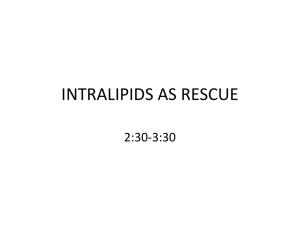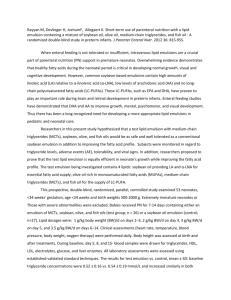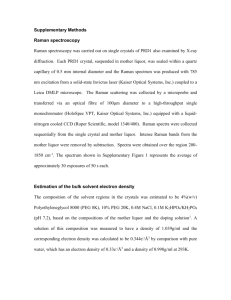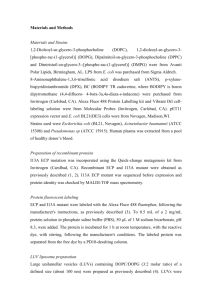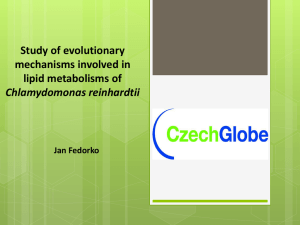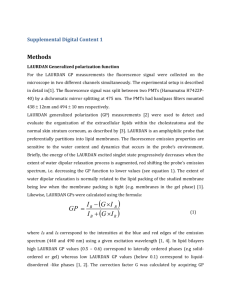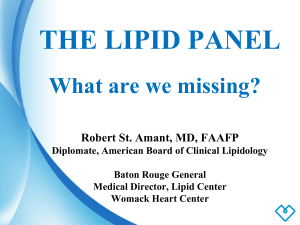Lipid Rescue Information
advertisement
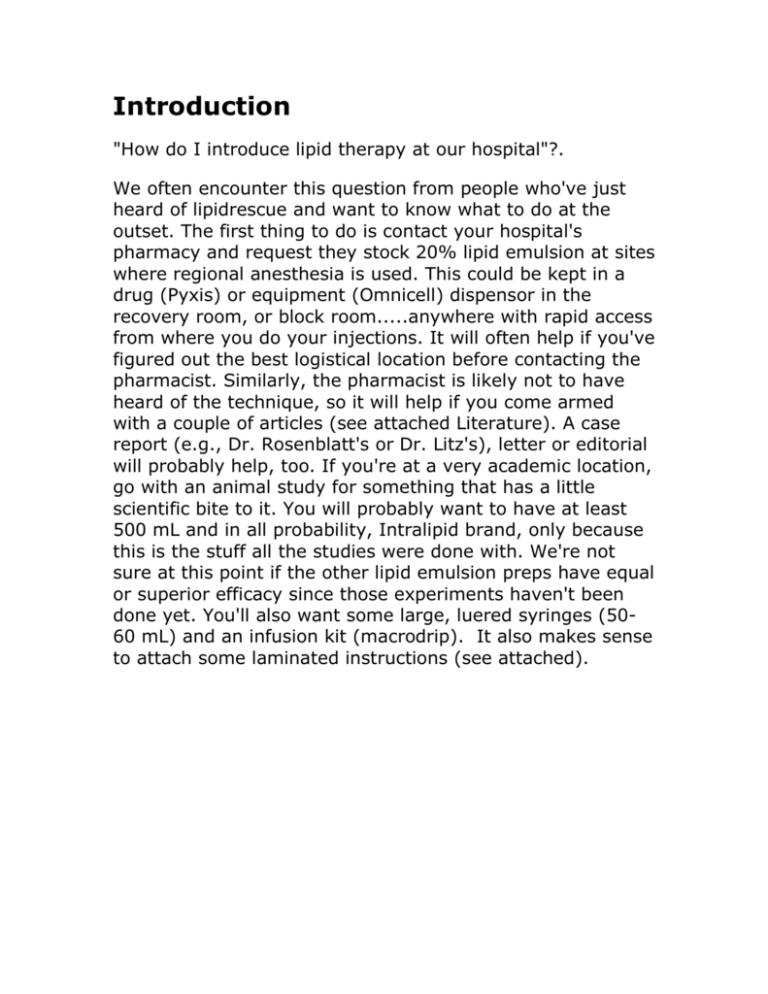
Introduction "How do I introduce lipid therapy at our hospital"?. We often encounter this question from people who've just heard of lipidrescue and want to know what to do at the outset. The first thing to do is contact your hospital's pharmacy and request they stock 20% lipid emulsion at sites where regional anesthesia is used. This could be kept in a drug (Pyxis) or equipment (Omnicell) dispensor in the recovery room, or block room.....anywhere with rapid access from where you do your injections. It will often help if you've figured out the best logistical location before contacting the pharmacist. Similarly, the pharmacist is likely not to have heard of the technique, so it will help if you come armed with a couple of articles (see attached Literature). A case report (e.g., Dr. Rosenblatt's or Dr. Litz's), letter or editorial will probably help, too. If you're at a very academic location, go with an animal study for something that has a little scientific bite to it. You will probably want to have at least 500 mL and in all probability, Intralipid brand, only because this is the stuff all the studies were done with. We're not sure at this point if the other lipid emulsion preps have equal or superior efficacy since those experiments haven't been done yet. You'll also want some large, luered syringes (5060 mL) and an infusion kit (macrodrip). It also makes sense to attach some laminated instructions (see attached). Treatment Regimens FIRST, A WARNING: There are no standard methods for lipid emulsion therapy. In fact, there are many more questions than answers: Should the lipid dose be titrated, by patient weight, local anesthetic dose, or the symptoms/signs/severity of toxicity? What is the best rate and total dose of the following infusion? Is there a safe upper limit of lipid dosing? What are the possible complications or adverse effects of lipid infusion? Should lipid be used alone or in combination with epinephrine, and other components of standard resuscitative cocktails? What is better, 20% or 30% lipid? What formulation is best? Intralipid has been used predominantly so far, but is there a better choice? Do the other available lipid emulsions work as well? Obviously, a great deal of research in this area is required to determine a treatment protocol that optimizes outcome. What is known about dosing? In animal studies, large doses of local anesthetic were used in order to make the most stringent possible tests for methods of treatment. Hence the doses of lipid used in rats and dogs (mL/kg) are probably excessive compared to what should work in humans who, by weight, have generally much smaller doses introduced into their circulation. Data from humans are limited to two case reports (see News) and no prospective epidemiologic study is possible since numbers are too small; and ethical considerations rule out experiments on volunteers. So these data are very limited as well. Both patients received bolus injections of 100 mL 20% Intralipid followed by continuous infusions at either 0.5 mL/kg/min for 2 hours, or 10 mL/min for 10 minutes. In both cases, the same general approach was used as in the animal experiments, namely a bolus followed by a continuous infusion. Given an understanding of these limitations in our method an Example Protocol follows; this should be used only after standard resuscitation methods fail to re-establish sufficient circulatory stability: 20% Intralipid: 1.5 mL/kg as an initial bolus, followed by 0.25 mL/kg/min for 30-60 minutes Bolus could be repeated 1-2 times for persistent asystole Literature ▪ Case Reports - (newest to oldest) See the 4 case reports from the May 2008 Anesthesia and Analgesia. Also, check out Sirianni's amazing case report! ▪ Liang CW, Diamond SJ, Hagg DS. Lipid rescue of massive verapamil overdose: a case report. J Med Case Reports. 2011 Aug 20;5(1):399 ▪ Jovic-Stosic J, Gligic B, Putic V, Brajkovic G, Spasic R. Severe propranolol and ethanol overdose with wide complex tachycardia treated with intravenous lipid emulsion: a case report. Clin Toxicol (Phila). 2011 Jun;49(5):426-30. ▪ Shih YH, Chen CH, Wang YM, Liu K. Successful reversal of bupivacaine and lidocaine-induced severe junctional bradycardia by lipid emulsion following infraclavicular brachial plexus block in a uremic patient. Acta Anaesthesiol Taiwan. 2011 Jun;49(2):72-4. ▪ McAllister RK, Tutt CD, Colvin CS. Lipid 20% emulsion ameliorates the symptoms of olanzapine toxicity in a 4-year-old. Am J Emerg Med. 2011 Jun 2. [Epub ahead of print] ▪ Mizutani K, Oda Y, Sato H. Successful treatment of ropivacaineinduced central nervous system toxicity by use of lipid emulsion: effect on total and unbound plasma fractions. J Anesth. 2011 Jun;25(3):442-5. Epub 2011 Mar 16. ▪ Castanares-Zapatero D, Wittebole X, Huberlant V, Morunglav M, Hantson P. Lipid Emulsion as Rescue Therapy in Lamotrigine Overdose. J Emerg Med. 2011 May 26. ▪ French D, Armenian P, Ruan W, Wong A, Drasner K, Olson KR, Wu AH. Serum verapamil concentrations before and after Intralipid® therapy during treatment of an overdose.Clin Toxicol (Phila). 2011 Apr;49(4):340-4. doi: 10.3109/15563650.2011.572556. ▪ Boegevig S, Rothe A, Tfelt-Hansen J, Hoegberg LC. Successful reversal of life threatening cardiac effect following dosulepin overdose using intravenous lipid emulsion. Clin Toxicol (Phila). 2011 Apr;49(4):337-9. ▪ Dix SK, Rosner GF, Nayar M, Harris JJ, Guglin ME, Winterfield JR, Xiong Z, Mudge GH Jr. Intractable cardiac arrest due to lidocaine toxicity successfully resuscitated with lipid emulsion. Crit Care Med. 2011 Apr;39(4):872-4. ▪ Harvey M, Cave G, Chanwai G, Nicholson T. Successful resuscitation from bupivacaine-induced cardiovascular collapse with intravenous lipid emulsion following femoral nerve block in an emergency department. Emerg Med Australas. 2011 Apr;23(2):209-14. ▪ Montiel V, Gougnard T, Hantson P. Diltiazem poisoning treated with ▪ ▪ ▪ ▪ ▪ ▪ ▪ ▪ ▪ ▪ ▪ ▪ ▪ ▪ hyperinsulinemic euglycemia therapy and intravenous lipid emulsion. Eur J Emerg Med. 2011 Apr;18(2):121-3. Franxman TJ, Al-Nabhan M, Cavallazzi RS, Speak AJ.Lipid emulsion therapy for verapamil overdose. Ann Intern Med. 2011 Feb 15;154(4):292. Benhamou D, Mazoit JX, Zetlaoui P. [Early administration of lipid rescue after initial signs of local anesthetic-induced systemic toxicity]. Ann Fr Anesth Reanim. 2010 Nov;29(11):826. Epub 2010 Nov 3. [Article in French] Aveline C, et al. Ineffectiveness of intralipid infusion for central nervous toxicity following ultrasound-guided sciatic nerve block with lidocaine-ropivacaine solution: interaction between carbamazepine, local anaesthetic and intralipid? 2010 Dec Please see Uncles, et al. reply in editorials Lin EP, Aronson LA.Successful resuscitation of bupivacaine-induced cardiotoxicity in a neonate. Paediatr Anaesth. 2010 Oct;20(10):955-7. doi: 10.1111/j. O'Brien TQ, Clark-Price SC, Evans EE, Di Fazio R, McMichael MA. Infusion of a lipid emulsion to treat lidocaine intoxication in a cat. J Am Vet Med Assoc. 2010 Dec 15;237(12):1455-8. Man D, Podichetty VK. Lipid rescue in resuscitation of local anesthetic-induced cardiac arrest in aesthetic surgery. Plast Reconstr Surg. 2010 Jun;125(6):257e-9e. Stellpflug SJ, Harris CR, Engebretsen KM, Cole JB, Holger JS. Intentional overdose with cardiac arrest treated with intravenous fat emulsion and high-dose insulin. Clin Toxicol (Phila). 2010 Mar;48(3):227-9. Cordell CL, Schubkegel T, Light TR, Ahmad F.Lipid infusion rescue for bupivacaine-induced cardiac arrest after axillary block. J Hand Surg Am. 2010 Jan;35(1):144-6. Wong GK, Joo DT, McDonnell C.Lipid resuscitation in a carnitine deficient child following intravascular migration of an epidural catheter*Anaesthesia. 2009 Oct 22. Marwick PC, Levin AI, Coetzee AR. Recurrence of cardiotoxicity after lipid rescue from bupivacaine-induced cardiac arrest. Anesth Analg. 2009 Apr;108(4):1344-6. Young AC, Velez LI, Kleinschmidt KC.Intravenous fat emulsion therapy for intentional sustained-release verapamil overdose. Resuscitation. 2009 May;80(5):591-3. Epub 2009 Mar 17. Weinberg G, Di Gregorio G, Hiller D, Hewett A, Sirianni A.Reversal of haloperidol-induced cardiac arrest by using lipid emulsion. Ann Intern Med. 2009 May 19;150(10):737-8. Finn SD, Uncles DR, Willers J, Sable N. Early treatment of a quetiapine and sertraline overdose with Intralipid.Anaesthesia. 2009 Feb;64(2):191-4 A very interesting case of reversing deep coma with lipidrescue. Saved the pt intubation and a night in the ICU. McCutchen G, Gerancher JC. Early lipid therapy may have prevented ▪ ▪ ▪ ▪ ▪ ▪ ▪ ▪ bupivacaine-associated cardiac arrest. Reg Anesth Pain Med. 2008; 33(2):178-180 A nice case report of patient with seizures and ventricular tachycardia responding to lipid + countershock. Patient did well. Smith HM, Jacob AK, Segura LG, Dilger JA, Torsher LC. Simulation education in anesthesia training: a case report of successful resuscitation of bupivacaine-induced cardiac arrest linked to recent simulation training. Anesth Analg. 2008 May;106(5):1581-4 A fascinating case that illustrates the value in educating physicians in LipidRescue methodology. A training session resulted in a clean save several months later. Warren JA, Thoma RB, Georgescu A, Shah SJ. Intravenous lipid infusion in the successful resuscitation of local anestheticinduced cardiovascular collapse after supraclavicular brachial plexus block. Anesth Analg. 2008 May;106(5):1578-80 An impressive save with lipid. Good ECG traces. Litz RJ, Roessel T, Heller AR, Stehr SN. Reversal of central nervous system and cardiac toxicity after local anesthetic intoxication by lipid emulsion injection. Anesth Analg. 2008 May;106(5):15757 Another great save with a very thought provoking discussion. Ludot H, Tharin JY, Belouadah M, Mazoit JX, Malinovsky JM. Successful resuscitation after ropivacaine and lidocaine-induced ventricular arrhythmia following posterior lumbar plexus block in a child. Anesth Analg. 2008 May;106(5):1572-4 The first report of LIpidRescue in a child. Foxall G, McCahon R, Lamb J, Hardman JG, Bedforth NM. Levobupivacaine-induced seizures and cardiovascular collapse treated with Intralipid. Anaesthesia. 2007 May;62(5):5168. Excellent case report of lipid reversing CNS and cardiovascular signs of toxicity. Zimmer C, Piepenbrink K, Riest G, Peters J. Cardiotoxic and neurotoxic effects after intravascular bupivacaine administration: therapy with lidocaine, propofol and lipid emulsion. Anaesthesist 2007 This is a chance to test your German. A very interesting case of toxicity presenting as agitation and SVT. They used clonidine first, then lidocaine, then propofol without success. All symptoms resolved after lipid infusion. Only one case but instructive. Sirianni AJ, Osterhoudt KC, Calello DP, Muller AA, Waterhouse MR, Goodkin MB, Weinberg GL, Henretig FM. Use of Lipid Emulsion in the Resuscitation of a Patient With Prolonged Cardiovascular Collapse After Overdose of Bupropion and Lamotrigine. Ann Emerg M See the Blog and News of 9-13-07. This is an absolutely amazing case. Spence AG. Lipid reversal of central nervous system symptoms of bupivacaine toxicity. Anesthesiology. 2007 Sep;107(3):5167 This may be the first example of purely CNS symptoms reversed by lipidrescue. Very well written case report as letter to the editor with good commentary. ▪ ▪ ▪ ▪ ▪ ▪ ▪ ▪ ▪ ▪ ▪ ▪ Rosenblatt MA, Abel M, Fischer GW et al. Successful Use of a 20% Lipid Emulsion to Resuscitate a Patient after a Presumed Bupivacaine-related Cardiac Arrest. Anesthesiology 2006;105:217-8. The first case report of successful resuscitation of a patient in prolonged cardiac arrest from presumed systemic local anesthetic toxicity. The patient recovered with no neurological sequelae after ~20 minutes of asystole and no response to ACLS. <s Litz RJ, Popp M, Stehr SN, Koch T. Successful resuscitation of a patient with ropivacaine-induced asystole after axillary plexus block using lipid infusion. Anaesthesia 2006;61:800-1. The second case report of lipid emulsion infusion successfully resuscitating a patient from apparently intractable cardiac arrest. This case involved ropivacaine. Editorials and Commentary For discussion of the recent letters in Anesthesiology see the link to Blog and News in the navigator Bet 2: intralipid/lipid emulsion in Beta-blocker overdose. [No authors listed] Emerg Med J. 2011 Nov;28(11):991-3 Kawaraguchi Y, Roth DM, Patel HH. From Local to Global: Intralipid Makes a Move. Anesthesiology. 2011 Jun 8. [Epub ahead of print] Uncles DR, Willers JW, Samuels TL, Chaklader A. Local anaesthetic systemic toxicity treated with intravenous lipid emulsion: ineffective treatment or selection of an inadequate lipid rescue dose? Eur J Anaesthesiol. 2011 May;28(5):390-1. Reply to Aveline C. See in case reports Weinberg GL. Intravenous lipid emulsion: why wait to save a life? Emerg Med Australas. 2011 Apr;23(2):113-5. doi: 10.1111/j.1742-6723.2011.01400.x Cave G, Harvey M. Intravenous lipid emulsion as antidote: How should we chew the fat in 2011? Crit Care Med 2011 Apr; 39(4): 919-20. Murray DB, Bateman DN.Use of intravenous lipids. Not yet in all overdoses with failed resuscitation.BMJ. 2011 Apr 8;342:d2265. doi: 10.1136/bmj.d2265. Samuels TL, Uncles DR, Willers JW, Monteiro R, Halloran C. Logging the potential for intravenous lipid emulsion in propranolol and other lipophilic drug overdoses. Anaesthesia. 2011 Mar;66(3):221-2. Davis W. Factors related to recovery in a cat treated for lidocaine intoxication. J Am Vet Med Assoc. 2011 Feb 1;238(3):284; author reply 284. Weinberg G, Lin B, Zheng S, Di Gregorio G, Hiller D, Ripper R, Edelman L, Kelly K, Feinstein D. Partitioning effect in lipid resuscitation: further evidence for the lipid sink. Crit Care Med. 2010 Nov;38(11):2268-9. ▪ ▪ ▪ ▪ ▪ ▪ ▪ ▪ ▪ ▪ ▪ ▪ ▪ Woehlck HJ, El-Orbany M.Anesthetic effects and lipid resuscitation protocols. Anesthesiology. 2010 Feb;112(2):499-500 McKevith J, Banks A. Lipid resuscitation. Resuscitation. 2009 Dec;80(12):1448. Epub 2009 Oct 4. Isherwood P. Lipid rescue: small trials and animal research. Anaesthesia. 2009 Dec;64(12):1380 Cave G, Harvey M. Intravenous lipid emulsion as antidote beyond local anesthetic toxicity: a systematic review. Anesthesiology. 2009 Sep;111(3):498-505. Picard J, Harrop-Griffiths W. Lipid emulsion to treat drug overdose: past, present and future. Anaesthesia. 2009 Feb;64(2):11921. Picard J, Ward S, Meek T. Antidotes to anesthetic catastrophe: lipid emulsion and dantrolene. Anesth Analg. 2007 Jul;105(1):2834 This is a very interesting comment, pointing out the similarities in terms of progress in acceptance of lipid for local anesthetic toxicity and dantrolene for MH. Brull SJ. Lipid emulsion for the treatment of local anesthetic toxicity: patient safety implications. Anesth Analg. 2008 May;106(5):1337-9 Excellent editorial on LipidRescue method. Rowlingson JC. Lipid rescue: a step forward in patient safety? Likely so! Anesth Analg. 2008 May;106(5):1333-6 An editorial by my mentor, John Rowlingson. Lipid infusion therapy: translation to clinical practice. Anesth Analg. 2008 May;106(5):1340-2 My editorial on the current state-ofthe-art. Picard J, Meek T. Lipid emulsion to treat overdose of local anaesthetic: the gift of the glob. Anaesthesia 2006;61:107-9. Weinberg GL.In defence of lipid resuscitation.Anaesthesia. 2006 Aug;61(8):807-8 Weinberg G. Lipid infusion resuscitation for local anesthetic toxicity: proof of clinical efficacy. Anesthesiology 2006;105:7-8. Groban L, Butterworth J. Lipid reversal of bupivacaine toxicity: has the silver bullet been identified? Reg Anesth Pain Med 2003;28:167-9. ▪ Research Articles (LipidRescue Resuscitation) ▪ Mauch J, Martin Jurado O, Spielmann N, Bettschart-Wolfensberger R, Weiss M. Paediatr Anaesth. Comparison of epinephrine vs lipid rescue to treat severe local anesthetic toxicity - an experimental study in piglets. 2011 Nov;21(11):1103-8. doi: 10.1111/j.14 NOTE PIGS ARE ALLERGIC TO LIPID EMULSION AND THEREFORE NOT A SUITABLE MODEL OF LIPID RESCUE ▪ French D, Smollin C, Ruan W, Wong A, Drasner K, Wu AH.Partition constant and volume of distribution as predictors of clinical efficacy of lipid rescue for toxicological emergencies.French D, Smollin C, Ruan W, Wong A, Drasner K, Wu AH. Clin Tox ▪ ▪ ▪ ▪ ▪ ▪ ▪ ▪ ▪ ▪ ▪ ▪ Oct 2011 Mauch J, Martin Jurado O, Spielmann N, Bettschart-Wolfensberger R, Weiss M. Paediatr Anaesth. Resuscitation strategies from bupivacaine-induced cardiac arrest. doi: 10.1111/j.14609592.2011.03688.x. 2011 Aug 29. [Epub ahead of print] Note: Pigs are allergic to lipid emulsion and therefore not a suitable model of lipid rescue Rahman S, Li J, Bopassa JC, Umar S, Iorga A, Partownavid P, Eghbali M. Phosphorylation of GSK-3β Mediates Intralipidinduced Cardioprotection against Ischemia/Reperfusion Injury. Anesthesiology. 2011 Jun 17. [Epub ahead of print] Bushey BA, Auld VH, Volk JE, Vacchiano CA. Combined lipid emulsion and ACLS resuscitation following bupivacaine- and hypoxiainduced cardiovascular collapse in unanesthetized swine. AANA J. 2011 Apr;79(2):129-38. Harvey M, Cave G, Lahner D, Desmet J, Prince G, Hopgood G. Insulin versus Lipid Emulsion in a Rabbit Model of Severe Propranolol Toxicity: A Pilot Study. Crit Care Res Pract. 2011;2011:361737. Epub 2011 Mar 31 Samuels TL, Uncles DR, Willers JW, Monteiro R, Halloran C. Logging the potential for intravenous lipid emulsion in propranolol and other lipophilic drug overdoses. Anaesthesia. 2011 Mar;66(3):221-2. doi: 10.1111/j.1365-2044.2011.06635 Kazemi A, Harvey M, Cave G, Lahner D. The effect of lipid emulsion on depth of anaesthesia following thiopental administration to rabbits. Anaesthesia. 2011 May;66(5):373-8. doi: 10.1111/j.1365-2044.2011.06690.x. Epub 2011 Mar Jensen-Gadegaard P, Skjønnemand M, Damgaard-Jensen J, Gottschau B. Limited knowledge of lipid rescue therapy in local anaesthetic systemic toxicity. Dan Med Bull 2011 Jan; 58(1): A4226 Lokajová J, Pukkila J, Holopainen JM, Wiedmer SK. In vitro capturing of various lipophilic illicit drugs by lipid dispersions. An electrokinetic capillary chromatography and fluorescence polarization study. Eur J Pharm Sci. 2010 Nov 20;41(3-4):51522. Epu Harvey M, Cave G, Prince G, Lahner D. Epinephrine injection in lipidbased resuscitation from bupivacaine-induced cardiac arrest: transient circulatory return in rabbits. Anesth Analg. 2010 Sep;111(3):791-6. Candela D, et al. Reversal of bupivacaine-induced cardiac electrophysiologic changes by two lipid emulsions in anesthetized and mechanically ventilated piglets. Anesth Analg. 2010 May 1; 110(5): 1473-9 Weinberg GL. Treatment of local anesthetic systemic toxicity (LAST). Reg Anesth Pain Med. 2010 Mar-Apr;35(2):188-93. Hiller DB, Di Gregorio G, Kelly K, Ripper R, Edelman L, Boumendjel R, Drasner K, Weinberg GL. Safety of high volume lipid emulsion ▪ ▪ ▪ ▪ ▪ ▪ ▪ ▪ ▪ ▪ infusion: a first approximation of LD50 in rats. Reg Anesth Pain Med. 2010 Mar-Apr;35(2):140-4. Hiller DB, Gregorio GD, Ripper R, Kelly K, Massad M, Edelman L, Edelman G, Feinstein DL, Weinberg GL. Epinephrine impairs lipid resuscitation from bupivacaine overdose: a threshold effect. Anesthesiology. 2009 Sep;111(3):498-505. Zhou Y, Zhan C, Li Y, Zhong Q, Pan H, Yang G. Intravenous lipid emulsions combine extracorporeal blood purification: a novel therapeutic strategy for severe organophosphate poisoning. Med Hypotheses. 2010 Feb;74(2):309-11. Epub 2009 Sep 27. Harvey M, Cave G, Kazemi A. Intralipid infusion diminishes return of spontaneous circulation after hypoxic cardiac arrest in rabbits. Anesth Analg. 2009 Apr;108(4):1163-8. Di Gregorio G, Schwartz D, Ripper R, Kelly K, Feinstein DL, Minshall RD, Massad M, Ori C, Weinberg GL.Lipid emulsion is superior to vasopressin in a rodent model of resuscitation from toxininduced cardiac arrest. Crit Care Med. 2009 Mar;37(3):993-9 Picard J, Ward SC, Zumpe R, Meek T, Barlow J, Harrop-Griffiths W Guidelines and the adoption of 'lipid rescue' therapy for local anaesthetic toxicity. Anaesthesia. 2009 Feb;64(2):122-5 A survey investigating the rate of adoption of AAGBI guidelines in the UK. Harvey M, Cave G. Survey of the availability of lipid emulsion infusion in Australasian emergency departments. Emerg Med Australas. 2008 Dec;20(6):531-3. A survey of general awareness among an Australian medical community of lipid rescue. Perez E, Bania TC, Medlej K, Chu J. Determining the Optimal Dose of Intravenous Fat Emulsion for the Treatment of Severe Verapamil Toxicity in a Rodent Model. Acad Emerg Med. 2008 Oct 25. [Epub ahead of print] These studies find the optimal dose of 20% lipid emulsion for resuscitating rats in verapimil overdose was 18mL/kg. Interestingly, we've found the optimal dose of 30% lipid emulsion for bupivacaine overdose is 12 mL/kg: exactly the same mass of lipid! Weinberg GL, Di Gregorio G, Ripper R, Kelly K, Massad M, Edelman L, Schwartz D, Shah N, Zheng S, Feinstein DL.Resuscitation with lipid versus epinephrine in a rat model of bupivacaine overdose. Anesthesiology. 2008 May;108(5):907-13 Epinephrine is shown in a rodent model of bupivacaine overdose to have adverse effects on hemodynamics and metabolic profile c/w lipid. Williamson RM, Haines J.Availability of lipid emulsion in obstetric anaesthesia in the UK: a national questionnaire survey. Anaesthesia. 2008 Apr;63(4):385-8 A survey of obstetric departments in the UK Bania T, Chu J, Perez E, Su M, Hahn I. Hemodynamic effects of intravenous fat emulsion in an animal model of verapamil toxicity resuscitated with atropine, calcium and saline. Acad. Emerg. Med. 2007; 14:105-11 A study in dogs shows that lipid infusion resuced subjects from high dose verapamil. In one limb, 14% survival in controls compared with 100% survival in the treated group. We hope this study will increase awareness of lipid rescue among toxicologists. ▪ ▪ ▪ ▪ ▪ Harvey M, Cave G. Intralipid Outperforms Sodium Bicarbonate in a Rabbit Model of Clomipramine Toxicity. Ann Emerg Med. 2006 Nov 9; [Epub ahead of print] This study shows that lipid infusion rescues rabbits given an overdose of clomipramine. Very similar to the dog bupivacaine studies, no animals given bicarb survived; all lipid-treated animals did (n=4 in each group). Corcoran W, Butterworth J, Weller RS, Beck JC, Gerancher JC, Houle TT, Groban L.Local anesthetic-induced cardiac toxicity: a survey of contemporary practice strategies among academic anesthesiology departments. Anesth Analg. 2006 Nov;103(5):1322-6. A excellent paper, the authors performed a survey of academic US anesthesiology depts on their preparation for local anesthetic systemic toxicity. They show a lack of general agreement on an approach to treating LA toxicity. Weinberg GL, Ripper R, Murphy P, Edelman LB, Hoffman W, Strichartz G, Feinstein DL. Lipid infusion accelerates removal of bupivacaine and recovery from bupivacaine toxicity in the isolated rat heart. Reg Anesth Pain Med. 2006 JulAug;31(4):296-303. Weinberg G, Ripper R, Feinstein DL, Hoffman W. Lipid emulsion infusion rescues dogs from bupivacaine-induced cardiac toxicity. Reg Anesth Pain Med. 2003 May-Jun;28(3):198-202. Studies in a dog model of acute bupivacaine toxicity find that all subjects treated with lipid exhibit return of normal hemodynamics while no controls recover. Weinberg GL, VadeBoncouer T, Ramaraju GA, Garcia-Amaro MF, Cwik MJ. Pretreatment or resuscitation with a lipid infusion shifts the dose-response to bupivacaine-induced asystole in rats. Anesthesiology. 1998 Apr;88(4):1071-5 This paper reports the original observation in rats that lipid prevents (pretreatment) and treats bupivacaine overdose. ▪ Research (Bupivacaine Cardiac Preservation) ▪ Ross JD, Ripper R, Law WR, Massad M, Murphy P, Edelman L, Conlon B,Adding bupivacaine to high-potassium cardioplegia improves function and reduces cellular damage of rat isolated hearts after prolonged, cold storage.Anesthesiology. 2006 Oct;105(4):74652. Ironically, bupivacaine is a good cardioprotectant. This suggests that bupivacaine toxicity should be entirely reversible, ▪ with no permanent cardiac damage. Weinberg G, Paisanthasan C, Feinstein D, Hoffman W. The effect of bupivacaine on myocardial tissue hypoxia and acidosis during ventricular fibrillation.Anesth Analg. 2004 Mar;98(3):7905, This paper reports that bupivacaine protects the heart against the tissue acidosis in 'no flow' states. This might explain successful lipid resuscitation in animals and case reports after long 'downtimes'. ▪ Reviews ▪ Mercado P, Weinberg GL. Local anesthetic systemic toxicity: prevention and treatment. Anesthesiol Clin. 2011 Jun;29(2):233-4 ▪ Ciechanowicz S, Patil V. Lipid emulsion for local anesthetic systemic toxicity. Anesthesiol Res Pract. 2012;2012:131784. Epub 2011 Sep 29 ▪ Fernandez, A et al. The use of intravenous lipid emulsion as an antidote in veterinary toxicology. J Vet Emerg Crit Care. 2011 June 3. ▪ Cave G, Harvey M, Graudins A. Intravenous lipid emulsion as antidote: a summary of published human experience. Emerg Med Australas. 2011 Apr;23(2):123-41 ▪ Bern S, Weinberg G. Local anesthetic toxicity and lipid resuscitation in pregnancy. Curr Opin Anaesthesiol. 2011 Apr 13. ▪ Bern S, Akpa BS, Kuo I, Weinberg G. Lipid resuscitation: a lifesaving antidote for local anesthetic toxicity. Curr Pharm Biotechnol. 2011 Feb 1;12(2):313-9. ▪ Skjønnemand M, Damgaard-Jensen J, Gottschau B. [Intravenous administration of lipids in poisoning caused by local analgesics]. Ugeskr Laeger. 2011 Jan 10;173(2):120-3. Danish. ▪ Toledo P. The role of lipid emulsion during advanced cardiac life support for local anesthetic toxicity.J Obstet Anesth. 2011 Jan;20(1):60-3. Epub 2010 Nov 26. ▪ Burch MS, McAllister RK, Meyer TA. Treatment of local-anesthetic toxicity with lipid emulsion therapy. Am J Health Syst Pharm. 2011 Jan 15;68(2):125-9. ▪ Sandlin-Leming DC. Resuscitation of local anesthesia-induced cardiac arrest: lipids to the rescue. J Perianesth Nurs. 2010 Dec;25(6):418-20. ▪ Lui KC, Chow YF. Safe use of local anaesthetics: prevention and management of systemic toxicity. Hong Kong Med J. 2010 Dec;16(6):470-5 ▪ Rothschild L, Bern S, Oswald S, Weinberg G.Intravenous lipid emulsion in clinical toxicology. Scand J Trauma Resusc Emerg Med. 2010 Oct 5;18:51. ▪ Dillane D, Finucane BT.Local anesthetic systemic toxicity. Can J Anaesth. 2010 Apr;57(4):368-80 ▪ Bourne E, Wright C, Royse C. A review of local anesthetic ▪ ▪ ▪ ▪ ▪ cardiotoxicity and treatment with lipid emulsion. Local and Regional Anesthesia. Feb 2010:3 11-19 Jamaty C, Bailey B, Larocque A, Notebaert E, Sanogo K, Chauny JM.Lipid emulsions in the treatment of acute poisoning: a systematic review of human and animal studies. Clin Toxicol (Phila). 2010 Jan;48(1):1-27. Leskiw U, Weinberg GL.Lipid resuscitation for local anesthetic toxicity: is it really lifesaving? Curr Opin Anaesthesiol. 2009 Oct;22(5):667-71 Weinberg, G. Lipid Rescue Resuscitation from Local Anaesthetic Cardiac Toxicity. Toxicological Reviews, Volume 25, Number 3, 2006, pp. 139-145(7) A summary of state-of-the-art as of December 2006. Includes lab background, some mechanism data and information on the first two cases. And you can buy it on the Ingentaconnect site for only $54. Guy L Weinberg, Malek G Massad, Metabolic modulation for cardiac protection.Expert Review of Cardiovascular Therapy, March 2007, Vol. 5, No. 2, Pages 135-138 A review of this promising approach to myocardial preservation. Malinovsky JM, Mazoit JX, Sztark F, Estèbe JP, Capdevila X, Samii K, Eledjam JJ, Benhamou D, Bonnet F, Bouaziz H, Weinberg G; Le Comité douleur-anesthésie locorégionale de Sfar. [Systemic toxicity of local anaesthetics and lipid emulsions: an interesting A very nice review of lipid emulsion therapy...in French ▪ Research: Metabolic Mechanisms of Bupivacaine Toxicity ▪ Weinberg GL, Palmer JW, VadeBoncouer TR, Zuechner MB, Edelman G, Hoppel CL.Weinberg GL, Palmer JW, VadeBoncouer TR, Zuechner MB, Edelman G, Hoppel CL. Bupivacaine inhibits mitochondrial transport of the heart's preferred fuel. ▪ Edelman LB, Ripper R, Kelly K, Di Gregorio G, Weinberg GL.Metabolic context affects hemodynamic response to bupivacaine in the isolated rat heart. Chem Biol Interact. 2008 Mar 10;172(1):4853. Epub 2007 Nov 13. This study in isolated heart indicates that hearts using lipid substrate are more sensitive to bupivacaine toxicity than those burning carbohydrate. ▪ Weinberg G, VadeBoncouer T.Improved energetics may explain the favorable effect of insulin infusion on bupivacaine cardiotoxicity.Anesth Analg. 2001 Apr;92(4):1075-6. A letter in reply to a study showing that insulin-glucose attenuates bupivacaine toxicity. We provide an alternate explanation. ▪ Weinberg GL, Laurito CE, Geldner P, Pygon BH, Burton BK.Malignant ventricular dysrhythmias in a patient with isovaleric acidemia receiving general and local anesthesia for suction lipectomy.J Clin Anesth. 1997 Dec;9(8):668-70 This is the index case for my interest in local anesthetic toxicity. This event led indirectly to the discovery of an antidote for this life-threatening ▪ condition. Onyüksel H, Sethi V, Weinberg GL, Dudeja PK, Rubinstein I.Bupivacaine, but not lidocaine, disrupts cardiolipin-containing small biomimetic unilamellar liposomes. Experiments supporting my theory that interaction with cardiolipin can explain bupivacaine's metabolic affects. ▪ Guidelines ▪ ACMT position statement: interim guidance for the use of lipid resuscitation therapy. American College of Medical Toxicology. J Med Toxicol. 2011 Mar;7(1):81-2 ▪ Neal JM, Bernards CM, Butterworth JF 4th, Di Gregorio G, Drasner K, Hejtmanek MR, Mulroy MF, Rosenquist RW, Weinberg GL. ASRA practice advisory on local anesthetic systemic toxicity. Reg Anesth Pain Med. 2010 Mar-Apr;35(2):152-61. ▪ Picard J, Ward SC, Zumpe R, Meek T, Barlow J, Harrop-Griffiths W. Guidelines and the adoption of 'lipid rescue' therapy for local anaesthetic toxicity. Anaesthesia. 2009 Feb;64(2):122-5. ▪ News Poisoning cure - give fat a chance. Poisoning cure - give fat a chance AMY CORDEROY July 12, 2011 IT may mean death for your diet but it turns out fat could save your life. An injection of fat could prove the antidote for some serious poisons, emergency doctors say. The fat solution is made from simple ingredients that could be bought at a supermarket - eggs and soybean oil - and has already been used to help save patients' lives. Medical records for 42 poisoned patients who received the treatment for cardiovascular or severe central nervous system problems showed some came back from the brink of death, and most showed improvement in their condition. Advertisement: Story continues below <iframe id="dcAd-1-3" src="http://adapac.doubleclick.net/adi/onl.smh.lands/lands/dietandfitness;ctype=article;cat=lands;cat1=dietandf itness;pos=3;sz=300x250;tile=3;ord=4.0810206E7?" width='300' height='250' scrolling="no" marginheight="0" marginwidth="0" allowtransparency="true" frameborder="0"> </iframe> Grant Cave, an emergency physician and intensivist at Tamworth Hospital, said the treatment was in its early days but held great potential as an antidote for poisonings from highly fat soluble medications such as local anaesthetic and some heart medications and antidepressants. The fat worked by helping the blood filter the poison from the body. It was already used occasionally as a last resort. "We call it 'lipid rescue' because you are rescuing people when all other methods have failed but they are still alive," he said. Dr Cave, who presented his findings at the Australasian College for Emergency Medicine winter symposium in New Zealand this week, has also compiled the first study of reports of the treatment. His research, published in Emergency Medicine Australasia, found 42 good quality reports of fat injection treatments, out of which 39 patients showed improvement ranging from minor to almost immediate resolution of their symptoms. But the study could not show how much of the improvement was due to the fat injection rather than other factors, Dr Cave said.


